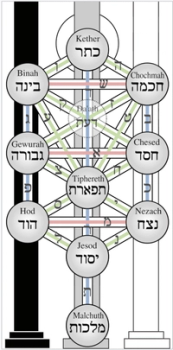
How the Paths on the Tree of Life Connect to the Major Arcana
The Major Arcana is far more than a lineup of striking archetypes. In the Hermetic Qabalah, these 22 cards represent the very paths that weave through the Tree of Life, carrying divine energy from one sephira (sphere) to another. Each card isn’t just a picture — it’s a living current, bridging sacred centers within the soul and cosmos.
Why This Matters for Tarot Practice
Grasping these connections radically expands how we read tarot. Rather than treating the cards as isolated meanings, we start to see them as part of a vast spiritual anatomy, each card a luminous link that channels specific forces between sephiroth.
This structure underpins much of modern Western esotericism, from the Golden Dawn to Thelemic magick, and shapes how decks like the Rider-Waite-Smith and Thoth Tarot encode deeper wisdom.
The Paths on the Tree of Life
Each of the 22 Major Arcana corresponds with a Hebrew letter and charts a path between two sephiroth. This is how the tarot reflects the flow of divine emanation through creation — and through you.
Here’s how traditional Golden Dawn correspondences lay out:
- The Fool (Aleph) links Kether to Chokmah — the pure breath of spirit into wisdom.
- The Magician (Beth) joins Kether to Binah — conscious will shaping understanding.
- The High Priestess (Gimel) flows from Kether to Tiphareth — intuition reaching the heart.
- The Empress (Daleth) connects Chokmah and Binah — love and intelligence united.
- The Emperor (Heh) bridges Chokmah to Tiphareth — directing force toward beauty.
- The Hierophant (Vav) ties Chesed to Chokmah — mercy suffused with divine insight.
- The Lovers (Zain) move from Binah to Tiphareth — integration of discernment with soul.
- The Chariot (Cheth) runs Binah to Geburah — discipline shaping strength.
- Strength / Lust (Teth) spans Chesed to Geburah — balancing grace with power.
- The Hermit (Yod) stretches Chesed to Tiphareth — inward seeking that refines mercy.
- Wheel of Fortune (Kaph) from Chesed to Netzach — fortune weaving love and desire.
- Justice / Adjustment (Lamed) Geburah to Tiphareth — aligning rigor with harmony.
- The Hanged Man (Mem) Geburah to Hod — sacrifice refining intellect.
- Death (Nun) links Netzach to Tiphareth — desire dying into higher soul.
- Temperance / Art (Samekh) Tiphareth to Yesod — integrating heart and foundation.
- The Devil (Ayin) from Tiphareth to Hod — confronting the shadow of self.
- The Tower (Pe) joins Netzach to Hod — sudden shifts in desire and thought.
- The Star (Tzaddi) traditionally connects Netzach to Yesod — hope flowing into emotion.
- The Moon (Qoph) stretches Netzach to Malkuth — instinct meeting the material.
- The Sun (Resh) runs Hod to Yesod — intellect enlightening the subconscious.
- Judgement / The Aeon (Shin) Hod to Malkuth — awakening intellect into manifestation.
- The World / The Universe (Tau) from Yesod to Malkuth — spirit completing in matter.
Crowley’s Revision: Tzaddi is Not the Star
Aleister Crowley famously shook this system in the Thoth Tarot. In The Book of Thoth, he declared “Tzaddi is not the Star.” Instead, he reassigned Tzaddi (צ) to The Emperor, moving Heh (ה) to The Star.
Why? Crowley believed the traditional attributions obscured a more profound spiritual reality tied to the Aeon of Horus — the new era of individual divine awakening. By shifting these paths, he sought to realign the tarot with what he saw as the true cosmic correspondences of this new Aeon.
In practice, this means that in the Thoth system:
- The Emperor becomes the path of Tzaddi, redefined as a direct channel from Netzach to Yesod, imbuing personal rulership with the power of awakened desire.
- The Star takes on Heh, connecting Chokmah to Tiphareth, pouring cosmic hope and inspiration into the soul’s core.
This is more than symbolic tinkering — for magicians working with the Tree of Life, these paths influence rituals, pathworkings, and the entire energetic map of spiritual ascent.
Reading Tarot Through This Lens
When you draw a Major Arcana card, you’re tapping into one of these vibrant paths. For example, pulling Temperance / Art isn’t only about harmony — it’s an active invitation to walk the path between Tiphareth (your heart, your solar center) and Yesod (the subconscious foundation).
Similarly, if The Tower appears, it signals disruption along the line from Netzach (desire) to Hod (intellect), urging a confrontation that breaks illusions and realigns truth.
For witches, Thelemites, Qabalists, and tarot readers weaving deep spiritual threads, these paths turn a simple reading into an exploration of your own inner Tree — a map of ascent, descent, and transformation.
Related Articles
How to Use Tarot for Meditation & Spiritual Growth
Discover how to use tarot as a powerful meditation tool. From simple daily focus to advanced Qabalistic pathworkings, learn how to let each card become a gateway to insight, healing, and spiritual growth.
How to Perform the Lesser Banishing Ritual of the Pentagram (LBRP)
Learn how to perform the Lesser Banishing Ritual of the Pentagram (LBRP) step-by-step. Discover its history in the Golden Dawn and Thelema, its spiritual meaning, and how modern students—both mystics and magicians—use it for balance, protection, and clarity.
Tarot & the Occult Revival: From Eliphas Lévi to the Golden Dawn
Explore how the tarot evolved from Renaissance playing cards into a cornerstone of Western occultism. From Eliphas Lévi’s Qabalistic theories to the Golden Dawn’s initiatory system and Crowley’s New Aeon, discover the roots that shape every serious tarot practice today.